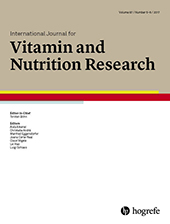Plasma Selenium Protein P Isoform 1 (SEPP1): A Predictor of Selenium Status in Nepalese Children Detected by Plasma Proteomics
Abstract
Abstract. Selenium deficiency or excess may have public health consequences, yet selenium status is infrequently characterized in populations, perhaps due to challenges in methodology. We are seeking to identify plasma proteins, using proteomics discovery and validation approaches, to serve as proxies for micronutrient status, including selenium, which may in the future be more readily assessed by robust, affordable field methods. In a sample of rural Nepalese children 6 - 8 years old (n = 500), the prevalence of selenium deficiency was 13.6 and 60.9 % at plasma selenium concentrations < 0.60 and < 0.89 µmol/L, respectively, assessed by atomic absorption spectroscopy. Relative abundance of selenoprotein P isoform 1 (SEPP1), glutathione reductase-3, and apolipoprotein A2 from discovery-based experiments was correlated with plasma selenium with a false discovery rate < 10 % (i. e., q < 0.10), all with p < 0.001. In linear mixed effects regression models to predict plasma selenium, only SEPP1 was significant (R2 = 0.63), estimating 8.2 % (95 % CI: 3.9 - 12.6) and 65.5(61.4 - 69.7)% of the in-sample population as deficient at each respective cut-off. Targeted quantification of SEPP1 in a preliminary series of specimens (n = 19) as a validation of the discovery approach revealed a high correlation with plasma selenium (r = 0.757, p = 0.0002). Plasma proteomics can identify valid plasma protein indicators of micronutrient status, as shown with selenium, comprising a step toward making population assessment of selenium status in vulnerable groups more accessible.


